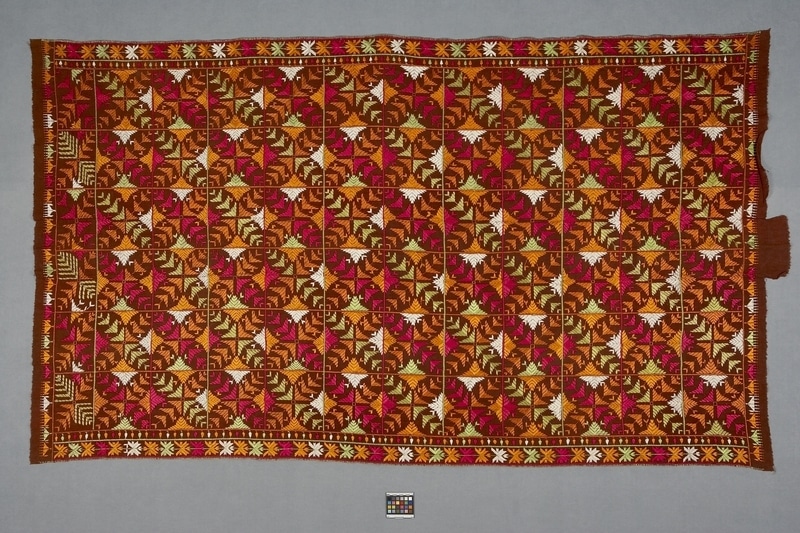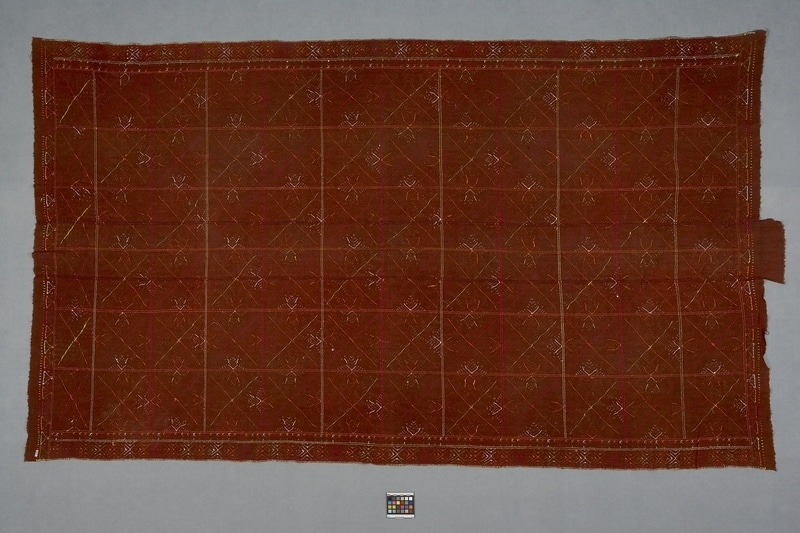Shawl Item Number: 1774/5 from the MOA: University of British Columbia


Description
Woman’s rectangular, embroidered shawl (headcloth). Made of brown, coarsely-woven cotton textile, embroidered over-all with brightly coloured, regularly spaced, squares that are arranged in 6 vertical rows of 12 each. The squares have stylized floral and leaf shapes in them, differing slightly in their predominance of 4 colours: orange, bright pink, light green and white; worked with a surface or “false” satin stitch. Border design of triangles at the ends, and borders of leaf motifs on the sides, which are finished with blanket stitch. The piece is constructed from three sections which were sewn together before the embroidery was worked.
History Of Use
Worn or used by rural women in Hindu, Sikh and Muslim communities, often as a head covering. Phulkari shawls have mostly gone out of fashion, due to changes in the social structure brought about by Westernization.
Specific Techniques
Techniques: surface or “false” satin stitch; cross stitch; blanket stitch. The stitches are worked from either the reverse side or from the front side, in surface or “false” satin stitch, and the design is visible only from the front. The pattern is formed by counting the threads and picking up a single thread, leaving a long “float” of thread on the front.
Iconographic Meaning
Bharme phullan (flowers) da bagh (garden) phulkari. Phulkari means “flower work” and is the name given to a regional embroidery style practiced throughout the Punjab, both in India and in Pakistan, as well as in neighbouring regions. The main body features a grid of flower motifs. The leftmost column of boxes alternates between magenta-gold flower boxes with green-gold wheat (kanak) motif boxes.
Item History
- Made in Punjab, India
- Owned by Penny Gouldstone
- Owned by Brian Gouldstone before November 10, 1998
- Received from Brian Gouldstone (Donor) on November 10, 1998
What
- Name
- Shawl
- Identification Number
- 1774/5
- Type of Item
- shawl
- Material
- cotton fibre, silk fibre and dye
- Manufacturing Technique
- sewn and embroidered
- Overall
- height 133.0 cm, width 230.0 cm
Who
- Culture
- Punjabi
- Previous Owner
- Penny Gouldstone and Brian Gouldstone
- Received from
- Brian Gouldstone (Donor)
Where
- Holding Institution
- MOA: University of British Columbia
- Made in
- Punjab, India
When
- Ownership Date
- before November 10, 1998
- Acquisition Date
- on November 10, 1998
Other
- Item Classes
- textiles
- Condition
- good
- Accession Number
- 1774/0005